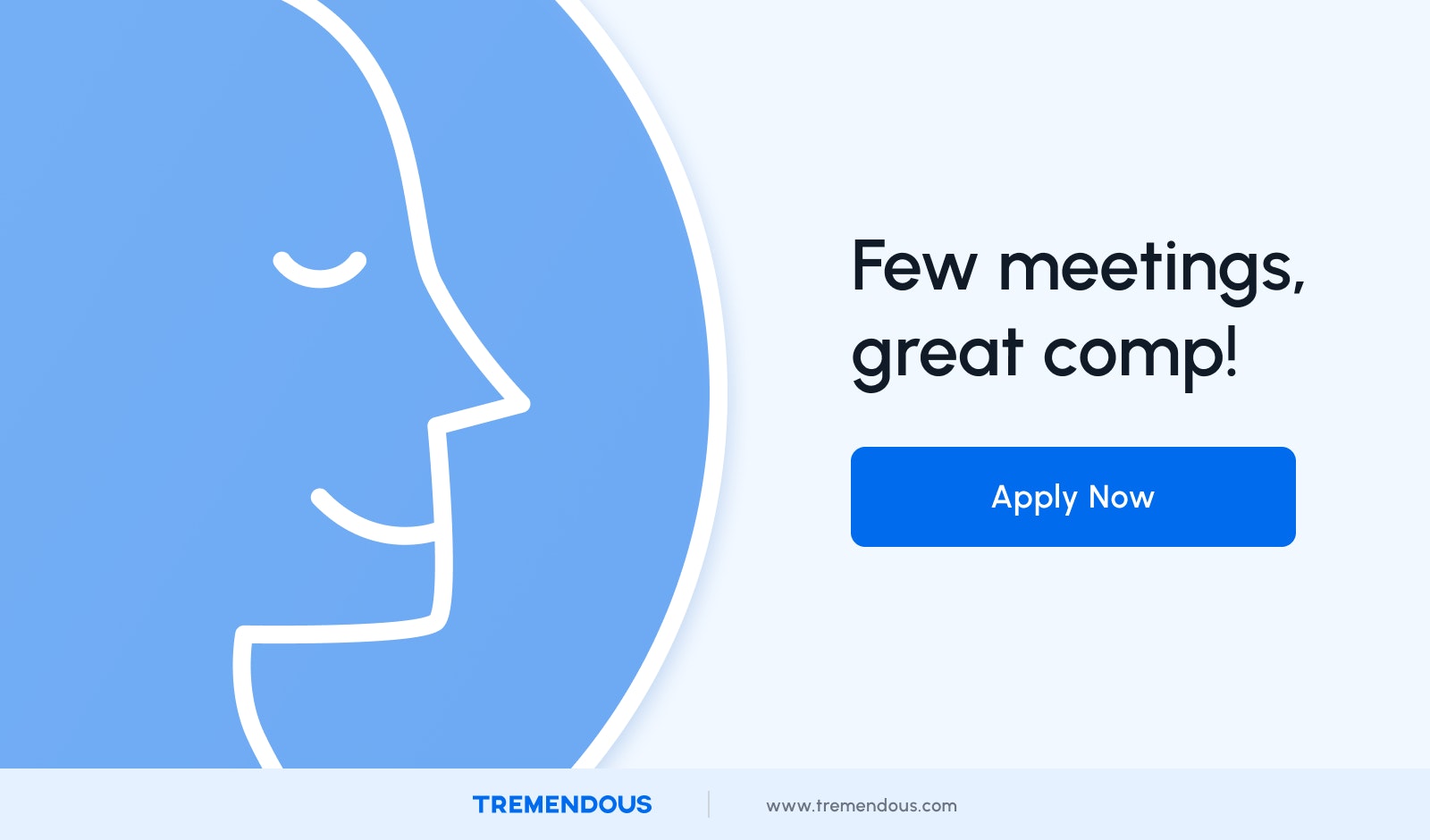A flow state makes your teams happier and more productive. Here’s why it’s important at work.
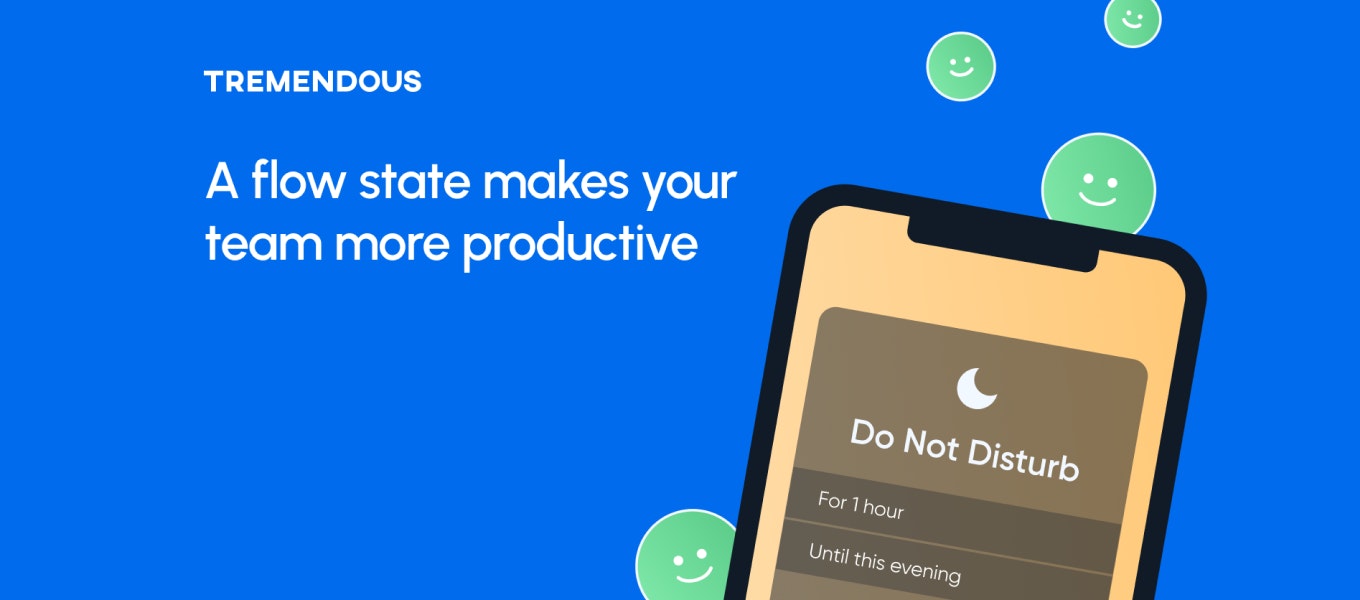
For far too many of us, it’s been months – maybe years – since we achieved a flow state. It’s not our fault. Achieving a flow state is difficult, especially in a pervasive culture of constant digital stimuli.
Intense, uninterrupted immersion, in which we actively create something without distraction, is what we mean when we say “flow state.” For organizations, having team members who work in a state of flow is ideal.
It allows them to produce high-quality results while maintaining an optimal level of happiness and satisfaction.
Tremendous emphasizes a culture that encourages team members to get into a flow state. However, finding your way there can be a bit challenging.
Here's a look at what a flow state is, what keeps us from entering a flow state, and how three Tremendous team members in different departments find their own way into a flow state.
Table of contents
This is what a flow state feels like
Distractions disappear. Time stands still. You actually enjoy what you’re doing. This is the concept of flow, and it's when you produce your best work.
First established by Hungarian psychologist Mihaly Csikszentmihalyi, a flow state is a period of optimal performance that’s so powerful that the person becomes entirely absorbed in what they’re working on, and time becomes irrelevant.
In her book Grit: The Power of Passion and Perseverance, Angela Duckworth refers to a flow state as one that is “intrinsically pleasurable.”
“You’re concentrating 100 percent. You’re not at all in problem-solving mode. You're not analyzing what you're doing, you're just doing.” writes Duckworth, a psychologist who teaches at University of Pennsylvania.
“You feel like you're in complete control because you are. You're floating, you lose track of time. No matter how fast you're running or how intensely you're thinking, when you're in flow, everything feels effortless,” she added.
It's a complete concentration that leads to a feeling of spontaneity. While you're actually at a high level of performance, it feels effortless. And even better— it's fun.
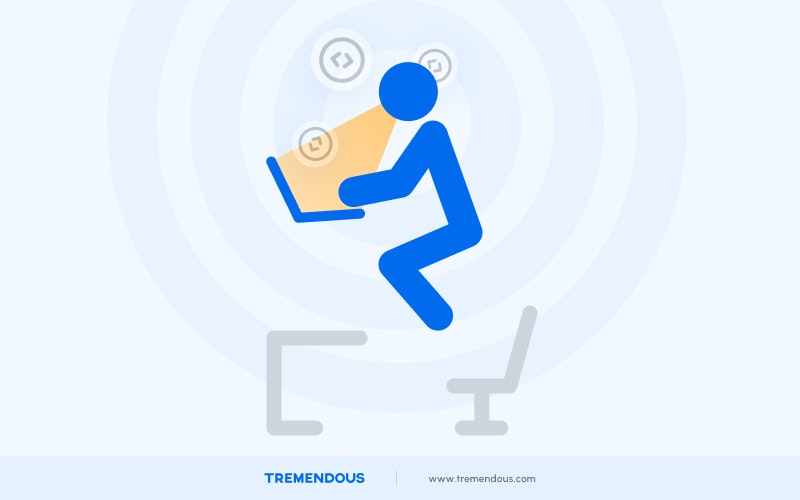
This is what’s stopping you from entering a flow state
In order to understand the benefits of working in a flow state, it's essential to look at the variables that currently affect the way we work.
We are in the midst of an attention crisis.
We are so susceptible to stimulation, that a subtle email notification can derail our work.
In a typical office, a never-ending barrage of meetings and colleagues means constant interruptions.
Add in the endless phone notifications and the addictive nature of social media, and focusing becomes increasingly difficult.
This is what happens when you can get into a flow state at work
In a flow state, you’re not only able to achieve intense concentration, but your level of creativity is increased. In fact, the scientific evidence behind flow shows entering that state greatly benefits your work.
According to a 2020 report in Behavioral Sciences, a 10-year longitudinal study showed people in flow states were 500% more productive.
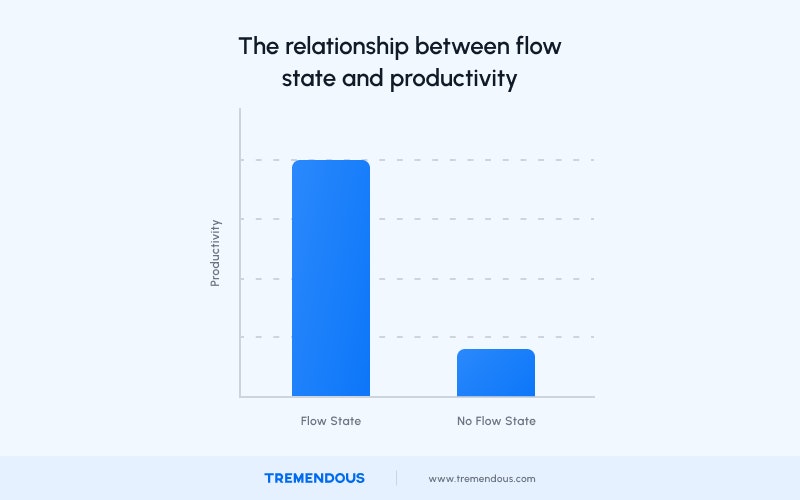
“Such increases have also been shown to impact positively on the associated group with many successful scientists, sports stars and artists mentioning flow as relevant to their work and improving their performance whether it be in sports, arts or workplace productivity,” reads the study’s findings.
Tremendous has consciously crafted an environment that encourages a flow state through a high-documentation, low-meeting work culture.
This workflow design reduces Slack pings, abrupt, mid-morning meetings, and frees up long, decadent stretches of time for every employee to do heads-down work.
But the best way to learn about the positive effects is by hearing from the team members themselves.
For engineers
The ability to work in a flow state functions for all different types of professional roles. Liz Sciortino, a senior software engineer at Tremendous, says it’s absolutely essential that she finds a flow state to accomplish her work.
Of course, that doesn’t mean she wasn't skeptical at first.
Initially, she was concerned that a culture that minimizes meetings wouldn't provide her with all the collaboration she needed to produce good work.
“How do you build team camaraderie? How do you facilitate communication, when you don't have built-in time for people to do that?” she wondered to herself.
But soon, she discovered that by eliminating back-to-back meetings that consume most of the day, colleagues are more eager to collaborate.
“I definitely have noticed a lot more willingness— people are willing to jump on something someone posted in the engineering channel and give feedback,” said Sciortino.
“I’ve had workplaces where it's like ‘can I get feedback?’ And it sits there silently. Without the stress of ‘oh I have to get to a meeting later’ means people are a lot more willing to do that stuff.”
To get into her flow state, Sciortino mutes her notifications, puts her phone on the other side of the room, grabs a cup of coffee, and finds some music that pumps her up.
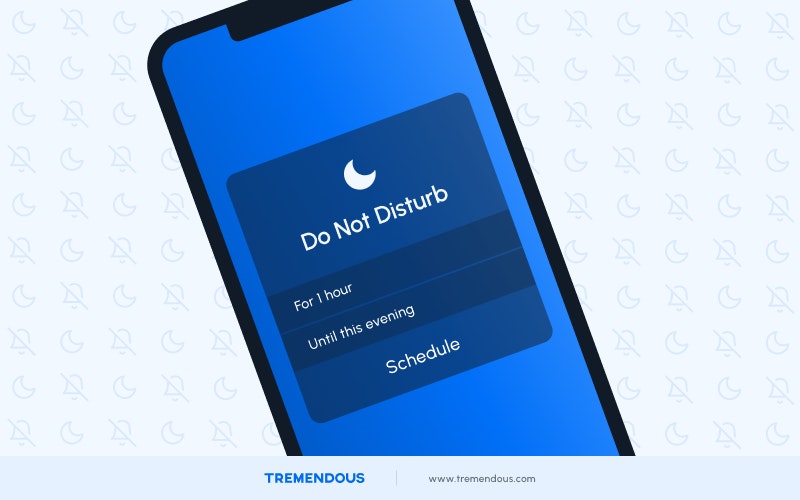
“For really in-depth engineering work that requires a lot of thought, you’re holding a lot of pieces in your head. Sometimes I’ll have 30 files open and I'm holding spots in those files in my brain. If you have to put it down and go to a meeting and come back to it, you lost all that time,” said Sciortino.
“You need that space for deeper engineering work.”
For CEOs
The concept of flow is encouraged for all members of Tremendous’ team, including its co-founder and CEO, Nick Baum.
“Generally, as a company, what we want to maximize is our number of flow state hours, not our work hours,” says Baum, who started out studying math and computer science in college.
When that was followed by years of working in programming, he realized how much more productive he could be in a flow state.
“In order to be effective, you need to essentially block out everything else. That's because in your mind, you're building up a stack of all these concepts and things you have to remember in order to make pieces function with each other. It's not something you can do while carrying on a conversation with another person,” says Baum.
“When someone comes along and says ‘hey, I got a question for you,’ even taking you away for 2 minutes, that depletes that stack that you built up in your head.”
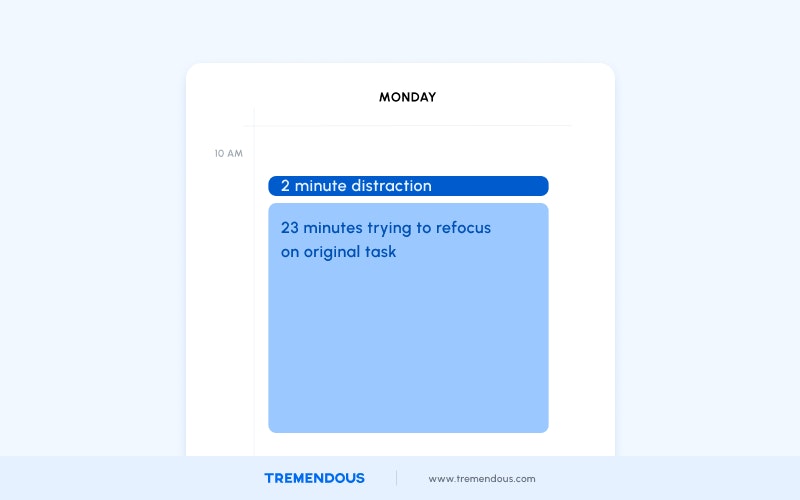
That’s why a system of minimal meetings and individualized structure is encouraged, along with high documentation, which allows information to be accessible across the organization.
“It decreases the number of pings, meetings, and questions about things people have already done,” added Baum.
Baum structures his day consciously in order to provide adequate time to get into a flow state.
A morning visit to the gym helps him get moving, followed by work he can do independently. He avoids scheduling morning meetings, instead preferring to leave those for the afternoon.
“Really it's about segmenting my time to allow me to say, ‘I’ve got this block, I’ve got 2 hours to focus on this one task at hand,” says Baum.
“When you're concentrated and you get into the zone, you move with the waters that are ushering your brain through whatever a topic or activity it is.”
For writers
Kate Monica, a senior content writer at Tremendous, says achieving a flow state has been a key contributor to alleviating her workplace anxiety.
"I would say that before I came to Tremendous, I hadn't achieved a flow state in years,” said Monica. “I hadn't been able to achieve that for so long because my attention span sucked.”
Monica attributes that inability to the disjointed culture in her previous roles, which emphasized constant meetings and intense administrative work.
“I was constantly interrupted, so it was virtually impossible to ever lose track of time,” she adds.
At Tremendous, which allows employees to structure their workday as they see fit, Monica has managed to find a steady state of flow.
One of the best ways she does that is by consciously utilizing the time away from her desk.
She wakes every day around 6 a.m. and works for a few hours, and then takes about two hours to go outside and skateboard in her apartment’s parking lot or the nearby skate park.
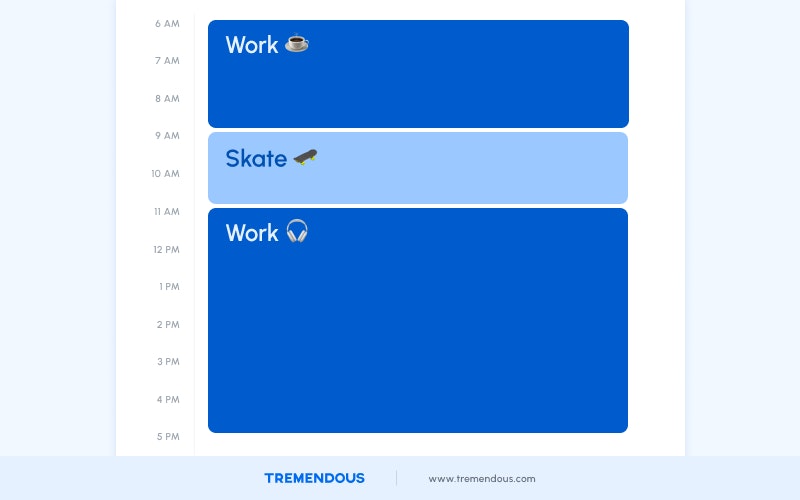
Without her laptop or cell phone, Monica is able to embrace the benefits of exercise and the creativity of skateboarding.
“I know I have two hours where no one's gonna ask me anything. No one is going to be looking for me. We can structure the day however we want,” she shared. “I can go skate right now, and I'm not bad for that.”
Monica’s statements that exercise benefits her ability to achieve a flow state are backed by science. It's no secret that exercise significantly helps improve focus and mental clarity.
When we exercise, blood flow increases throughout the body, moving more intensely to our brain and stimulating the brain’s muscles.
According to the American Psychological Association, exercise can improve brain functions like memory and cognition immediately after a workout, and in the long term.
By skateboarding, Monica is ensuring she can enter a flow state when she returns to her workspace. Back at her desk, Monica turns on instrumental music, like the soundtrack to the TV series Succession.
“When I'm in that groove, I’m not aware of what time it is. I forget everything about who I am and what I have to do later. I’m singularly focused. When I'm in the zone, everything outside of the task melts away, so the task becomes easier and more enjoyable because I had that nice break. And that's absolutely invigorating and thrilling for me.”
Monica also notes part of that success is due to Tremendous’ culture of remote work, which she calls “super important."
“I can get up and think and pace. That is important in my process,” she says. “That’s not possible in an office.”
Prioritize a flow state. It’s important.
Getting to a place where you can produce your best work can be challenging. After all, we’re inundated with stimuli all day long, from messages on Slack to kids asking for help with their homework.
That means finding your focus can feel next to impossible. But there are certain things you can do to encourage yourself to find the sense of flow to push forward.
In each of our case studies previously mentioned, the Tremendous employees found it beneficial to minimize the distractions that creep up throughout the day.
They silence their phones and turn on music that inspires them.
They also have activities they practice outside their workplace that allow them to unplug, whether it's skateboarding in the parking lot or taking a walk.
By allowing time to pursue their individual interests, they’re able to stay fully present when they’re working.
But one of the most beneficial components of achieving a flow state is the experience of being challenged.
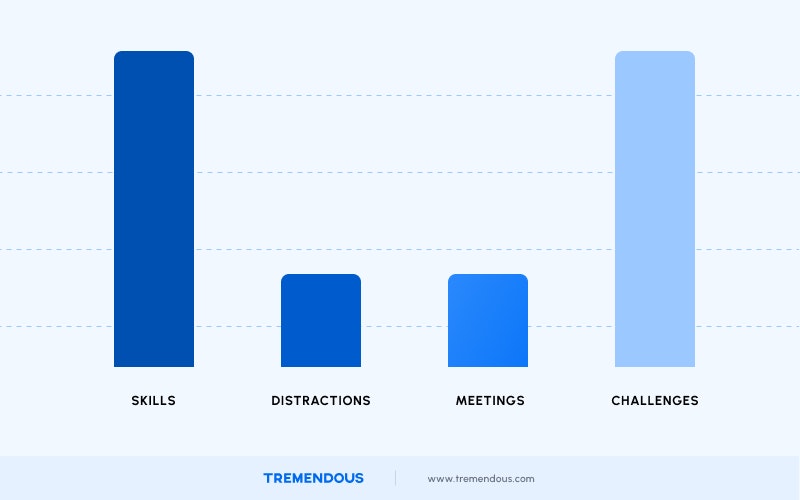
According to Csikszentmihalyi, a flow state is accessed when both skills and challenges are high.
Simply put, the best examples of flow come when the person is actively challenged to work toward a goal, resulting in the highest quality work.
Challenging work is, well, challenging. But it’s also intellectually, professionally, and personally gratifying.
Putting yourself or your colleagues in a position to do more gratifying, challenging work will make everybody happier and more productive. And that’s better for your brain, your output, and the company as a whole.
